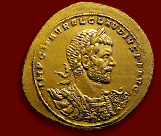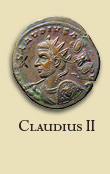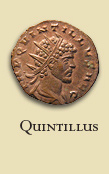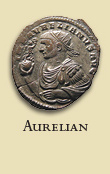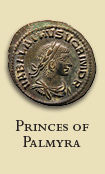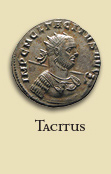History
268: (Aspasius) Paternus II, Marinianus coss.
At the news of the defection of Aureolus, who had been entrusted by Gallienus with the defence of Raetia against the barbarians, and of northern Italy against a possible attack by the Gallic empire, Gallienus left the Balkans, where his victory on the Nestos river in the Rhodope mountains (spring of 268) had finally restored Roman military supremacy over the Herulian Goths.
Leaving his dux Marcianus to continue the war, Gallienus reached Milan in northern Italy. This was where Aureolus had his headquarters and where he was employing the mint to strike coins in the name of Postumus, as he did not himself claim the title Augustus. Aureolus was defeated and was besieged in Milan, but then Gallienus became the victim of a conspiracy by high-ranking officers and was assassinated in late August or early September 268. These officers included the praetorian prefect Heraclianus, Claudius and probably Aurelian.
Claudius was then proclaimed emperor. On his accession, he was without doubt the commander of the cavalry, to which position he had been appointed by Gallienus some months previously to replace Aureolus. Aureolus, who thought he would be able to negotiate a pardon with Claudius, was rapidly eliminated. The imperial army entered Milan, where a sumptuous gold donative was given out to the troops to quieten any opposition and to facilitate rallying of supporters.
The retreat of the Roman army commanded by Aureolus in northern Italy had left Raetia and the zone between the Rhine-Danube frontier and the Alps vulnerable to attack from the Alamanni. Claudius II’s first task was to repel a wave of invaders who, having crossed the Alps, poured into the Po valley: the Roman victory at Lake Garda put a stop to the invasion and earned Claudius the title of Germanicus maximus (CIL XII, 2228, dated 269). At the end of the year 268, Claudius was able to enter Rome to celebrate his accession, his victory over the Alamanni and to assume the consulship on 1 January 269.
269: Imp. Caes. M. Aurelius Claudius Aug., Paternus coss. 
Claudius established a forward defence line against the Gallic Empire to the east of the province of Narbonensis, an expeditionary force stationed at Cularo (Grenoble) under the command of Julius Placidianus, prefect of the vigiles. However, the status quo between the Central empire and the Gallic empire held. The inhabitants of the city of Autun learned it to their own expenses: encouraged by the advance of the imperial army to the east of the Rhone, they rebelled against the Gallic empire. They paid for their tactical error by enduring a long siege of seven months led by the Gallic emperor Victorinus, and their defeat was followed by the exile of their leaders.
A military crisis was developing at the other end of the empire: the Herulian invasion, which had barely been quelled by Gallienus, was followed by a wave of Goths from the Black Sea. A confederation of Goths, Heruli and Peuci headed from the mouth of the Dniestr River on board a flotilla of boats – according to Zosimus there were 320,000 men on 6,000 ships – and ravaged the coasts of Lower Moesia, though they were unable to take the towns of Tomi and Marcianopolis. The Gothic fleet passed through the Bosphorus into the Propontis where strong currents sunk a number of the vessels. The Goths unsuccessfully attacked Byzantium and Cyzicus and reached the Aegean sea. Part of the Gothic fleet then continued south, bypassing Thessaly and Greece and ravaging the countryside. However, they were unable to take the cities which had been hastily fortified following the previous Herulian raid. Another part of the barbarian fleet attacked the Chalcidice peninsula, where they landed in order to regroup. They then laid siege to the cities of Cassandrea (Potidaea) and Thessalonica but failed to take them.
At the news of the approach of the imperial army, these bands got deeper into the mainland through the region of Pelagonia in Macedonia, where they faced the first Roman assault from the Dalmatian cavalry, perhaps led by the future emperor Aurelian, whom Claudius had put in command of the cavalry.
The Goths were crushed further north in the valley of the Morava near Niš (Naissus) in Moesia Superior. According to Zosimus 50,000 of the barbarians were killed. Despite heavy Roman losses, the battle was a resounding success and earned Claudius II the title of Gothicus maximus. The battle took place in the autumn of 269. The Roman cavalry forced the barbarians, who were starving and decimated by plague, towards Macedonia, then Thrace and the Haemus mountains and their final annihilation by the legions occurred several months later in 270, this delay being caused by dissension between the Roman infantry and cavalry commanders.
270: Flavius Antiochianus II, Virius Orfitus coss.
The expansion of Palmyra 
While the empire was dealing with the Gothic invasion, a new danger arose from the ambitious rulers of Palmyra in the East. The assassination of Odenathus and his eldest son Herodian at the behest of Gallienus, which can be dated by coins of Vabalathus to the Egyptian year August 267 – August 268, had put a temporary halt to the political and economic ambitions of Palmyra. However under Queen Zenobia the Palmyrene kingdom returned to a policy of active expansion in the reign of Claudius II, as she enjoyed much greater freedom of movement: the Sasanian Empire was seeking a successor to the old King of Kings Shapur and the Roman armies and fleets were occupied tracking down Gothic bands in the Balkans and Eastern Mediterranean.
The Palmyrene stranglehold on the Roman provinces was initially unnoticed. More than a military expansion, it was based on the control exercised by pro-Palmyrene factions on important cities and strategic centres of power. Syria passed into Palmyrene hands in 270, before the death of Claudius. The third and fourth issues from the mint at Antioch - especially the fourth posthumous issue, which was very different from the consecration issues minted in the rest of the empire at the death of Claudius II - were produced under the rule of Palmyra: they display a completely new iconography, featuring pairs of deities, one male, one female, who discreetly allude to the double patronage of Vabalathus and Zenobia.
From Syria, the Palmyrenes took control of the Anatolian provinces, as far as Ancyra in Galatia, Bithynia and even the city of Chalcedon which put up a resistance on Aurelian’s proclamation as emperor. Provincial and civic Greek coinages dried up and the last mints in activity in Pisidia were closed. Further south, Arabia passed to into Palmyrene hands despite the resistance of Roman forces, notably that of the Legio IIIa Cyrenaica at Bostra. The Via Nova, the great strategic and commercial route between Syria and the Red Sea also fell into the hands of the Palmyrenes.
Taking advantage of the absence of the prefect of Egypt, Tenagino Probus, who had been commissioned by Claudius II to hunt down the remaining Gothic fleet scattered throughout the eastern Mediterranean, the Palmyrenes conquered Egypt. A pro-Palmyrene party, led by Timagene who was Egyptian-born, had paved the way, and in an initial campaign the Palmyrene general Septimius Zabdas defeated the Roman troops. The army of Palmyra then withdrew, leaving behind a garrison of 5,000 men. When he learned of this, the prefect Tenagino Probus returned to Egypt and put to flight the Palmyrene garrison. A new war broke out between the imperial army and the Palmyrene forces. Tenagino Probus and his army were victims of an ambush by Timagene; the prefect of Egypt was captured and committed suicide.
While the princes of Palmyra were profiting from the Romans’ difficulties to become masters of the East (it would fall to Aurelian to deal with the Palmyrene secession), Claudius left behind part of his army to complete pacification of Moesia and Thrace, while he departed in the early summer of 270 to protect Pannonia which was threatened by an invasion of Vandals. The emperor was at Sirmium with his staff when he died of the plague in August 270. Alexandrian tetradrachms from his third year (after 29 August 270) are numerous and papyri attest that news of his death was not known in the chôra by September-October 270. Other Egyptian records show that by 12 October 270, Egypt had received two pieces of important news - that of the death of Claudius and that of the struggle for power between Quintillus and Aurelian: over a period that lasted until at least 11 November 270, the papyri are not dated in the name of an emperor, but use the vague formula ‘under the consuls of the year’, reflecting the embarrassment of the scribes regarding this confused political situation.
Throughout the same period in the Delta, the Alexandrian mint briefly issued coins first in the name of Quintillus, then in the name of Aurelian alone year 1, until Vabalathus began appearing on the reverse of Alexandrian tetradrachms at a date that can be set at December 270 from the evidence of the papyri.
Chronological problems: the dated coins
Numismatic evidence does not permit us to place the death of Claudius II as early as the beginning of 270, as has sometimes been suggested. The coins of Claudius are not of much help for dating because, even though the issues of the various mints can be placed in sequence, they do not provide an absolute chronology. The rare ‘dated’ coins of the reign refer to the tribunician power (Tr P) without noting its iteration: the type P M Tr Po P P (wolf and twins), issued by the eastern ‘SPQR mint’, does not mention Claudius’s consulship and therefore may be dated to 268; P M Tr P Cos P P (Apollo seated), from the fourth and final issue of Siscia, alludes to Claudius’s third Tr P, which began on 10 December 269. The coins of the second issue of the mint at Milan show the emperor in consular dress and therefore postdate 1 January 269.
Only the mint at Rome issued reverses on which the tribunician power is iterated, and these refer exclusively to Tr P II (10 December 268 - 9 December 269): the two antoniniani types P M Tr P II Cos P P (emperor togate, left) of issues 1 and 2, and P M Tr P II Cos P P (emperor in military dress, right) of issue 3. The same legend also appears on an aureus and a medallion.
Rome did not issue any coins dated Tr P III (after 10 December 269). In order to explain this anomaly, we must consider three factors: the disorganization of the Roman mint following the large inflationary issues of Gallienus (the ‘7th consulship’ and the ‘Bestiary’ issues) from at least the year 266; the forgeries struck on the margins of the Roman mint and even probably within the mint itself; and the reaction of the Empire to these practices before the brutal repression by Aurelian in 271 against the moneyers of Rome.
From the absence of dated coins from the 3rd tribunician power of Claudius II, we can deduce that the mint at Rome was officially shut down at the beginning of 270, a measure that certainly did not stop the fraudulous minting of the previous coin types, including those dated to the second tribunician power which had become obsolete.
But there is no reason to deduce from numismatic evidence that Claudius II died at the beginning of 270. Even though no coins from Rome mention Claudius’s third tribunician power starting on December 269, this is well attested on inscriptions, Tr P III: CIL II, 1672 (Baetica); CIL III, 3521 (Aquincum, Pannonia Inferior); Tr P II and Cos II: CIL VIII, 23972 (Africa Proconsularis); Tr P III and Cos II: CIL XVII/2, 159 (Narbonensis); CIL II, 3834 (Tarraconensis); CIL VIII, 4876 (Numidia Proconsularis).
The mention of a 2nd consulship, which, in addition to the inscriptions cited above, also occurs on two other tituli from Tarraconensis (CIL II, 3619 and 4505), apparently implies that Claudius was designated for a consulship which, because of the Gothic war, he did not actually take up on 1 January 270. The consuls of the year 270 were members of the senatorial aristocracy, the prefect of Rome, Flavius Antiochianus, consul for the second time, and Virius Orfitus, who was then to be the prefect of Rome in 273-274.
A group of coins issued at Rome appear to mention a second consulship of Claudius (P M Tr P Cos II P P, emperor togate, left), but this is in fact an error that occurs on one single die, on which the engraver reversed part of the legend of the 2nd issue, P M Tr P II Cos P P. The obverse legend Imp C Claudius Aug of these coins places them in the 1rst issue of Rome, while the mention of a second consulship should have placed them in the 3rd and final issue of Claudius at Rome (with obverse Imp Claudius Aug).
According to Zonaras, the dying Claudius II had appointed Aurelian as his successor in the presence of his staff gathered at Sirmium, which does not necessarily mean that Aurelian was present in person at the time. On the contrary, the facts that the army proclaimed the brother of Claudius, Quintillus, as his successor and that the Senate at Rome recognized Quintillus as emperor, suggests that Aurelian was still on the Lower Danube to deal with the final attacks of the Goths, who were again menacing Nicopolis in Moesia Inferior and Anchialos in Thrace in Quintillus’s reign.
The choice of Quintillus as Claudius’s legitimate successor was dictated not just by the need to appoint a ruler quickly and his proximity to Rome, but also by his ability. Quintillus was at this stage in northern Italy where he had been posted to ensure its protection at the head of the expeditionary force stationed in Milan, a difficult task that Claudius could not have given to anyone but a trusted man. Quintillus’s accession to power was recognized throughout the Empire: all the mints struck coins in his name, including that of Alexandria in Egypt. At Antioch in Syria the last issues in the name of Claudius II were issued by the Palmyrenes. In Rome, the single, but abundant issue of antoniniani in Quintillus’s name was produced in his absence and the mint did not strike any gold coins to celebrate his accession: Quintillus did not have time to come and claim official recognition in the capital. On the other hand, the two issues of antoniniani in Milan, and the richness of the gold donative struck for the army, show that he had his headquarters in Milan.
As for the mints of Siscia and Cyzicus, they quickly passed into the hands of Aurelian after producing a brief series of antoniniani in the name of Quintillus.
There is conflicting evidence regarding the length of the reign of Quintillus: the Chronograph of 354 indicates that he reigned for 77 days, Eutropius suggests a reign of only 17 days, followed by the Historia Augusta, Orosius, St. Jerome, Syncellus and Zonaras. The difference is perhaps due to the fact that the Chronograph of 354 takes into account the complete duration of Quintillus’s reign, from his proclamation by the army to his elimination at Aquileia, while the other sources only count the length of time during which Quintillus reigned alone, before Aurelian was in turn proclaimed emperor. Quintillus’s reign must therefore have started around mid-August 270 and finished at the beginning of November 270, with the proclamation of Aurelian at Sirmium at the beginning of September. The suggestion that Quintillus’s reign lasted just 17 days is contradicted by the size of the coin issues struck for him.
Two inscriptions are known that name Quintillus as Augustus, one, from Mauretania Caesariensis and the other from Sardinia. A third inscription, also from Sardinia, is particularly interesting since Quintillus is not given the title of Augustus until subsequently, after the stone has been recarved and the inscription retouched: the milestone was originally dedicated to the emperor Claudius by Quintillus in 268, when the latter was procurator of the province of Sardinia. In 270, on Quintillus’s accession, the inscription was clumsily recarved and the dedication to Claudius was retouched and changed from the singular to the plural Invictis Augg (Augustis).
The military campaigns at the beginning of Aurelian’s reign (September 270-mid 271)
The lack of reliable historical sources makes reconstruction of the campaigns at the beginning of Aurelian’s reign rather difficult. It seems that we must reverse the order in which the two fragments of Dexippus that mention these campaigns appear in the Excerpta de legationibus gentium ad Romanos compiled for Constantine Porphyrogenitus, as this inversion is supported by numismatic evidence.
From the Lower Danube, where the news of Claudius’s death reached him, Aurelian hurried to Pannonia in order to put himself at the head of the army that was assembled there, perhaps more with the intention of leading military operations against the Vandal invasion than in order to seize power. He was proclaimed emperor by the army based at Sirmium and the Pannonian mint of Siscia began immediately striking coins in his name from September 270.
The use of Sirmium as his headquarters and the mention that the Sarmatian Iazyges had joined the Vandal invaders indicate that the threatened area was situated on the Hungarian plain between the Danube and Tisza, opposite Pannonia Inferior. The Vandal campaign was short and an imperial victory forced the barbarians to negotiate. A treaty was concluded: barbarian hostages were given to the Romans, 2,000 Vandal horsemen joined the Roman auxiliary forces, while the rest of the Vandal forces were supplied with provisions and escorted to the Danube.
Aurelian gave orders for an imperial donative to be prepared by the mint of Siscia to celebrate two events: the victory over the Vandals and the defection of Quintillus’s armies to Aurelian’s side. Claudius’s brother, who had moved against his rival, had been eliminated by his own troops at Aquileia before he could even pass the Julian Alps at the beginning of November 270.
However, Aurelian was forced to leave Pannonia as soon as he had concluded the treaty with the Vandals, as news came that the Juthungi had invaded Italy: the departure of Quintillus’s army from Milan had left Transpadane Italy defenceless. Dexippus mentions ‘the new return of the Juthungi’ to Italy. It was effectively the third time in ten years that the Juthungi, this time in league with the Alamanni, had invaded and pillaged north Italy. In spring 260 Gallienus had stopped an invasion in northern Italy: a heterogeneous army raised in Raetia and commanded by the acting governor M. Simplicinius Genialis had crushed the barbarians in their retreat before they could even cross the Danube. In the autumn of 268 Claudius II had stopped another invasion on Lake Garda.
It seems that Aurelian had no difficulty in eliminating the first wave of invaders, but he then committed the error of underestimating the barbarian threat to Italy: he moved to Milan, to the headquarters of his defeated rival Quintillus, intending to spend the winter there to consolidate his power-base with the army. He commissioned an important gold donative from the mint of Milan, which displays the same types that had appeared shortly before at Siscia: they celebrate the restoration of concordia between the armies of Quintillus and Aurelian, and also call for the restoration of the borders of Pannonia and Dacia.
This programme of reconquest of the Balkan provinces proved obsolete as soon as it was conceived: the invasion of the Alamanni and Juthungi developed rapidly in northern Italy at the turn of 270-1, the Juthungi taking an eastern route to Italy across Noricum by the Via Iulia Augusta, while the Alamanni took routes through Raetia, following the upper Rhine or the Via Claudia Augusta. The mobility of the barbarian horsemen made them hard to catch and the imperial army exhausted itself trying to pursue them. The raids ravaged the countryside of Transpadane Italy, although the Germanic bands avoided the well fortified larger towns of the Po valley. The first contact with the barbarians was a disaster; Aurelian was beaten at Plaisance. The Via Cassia and the Via Aemilia were left wide open to the invaders.
>>> 271

